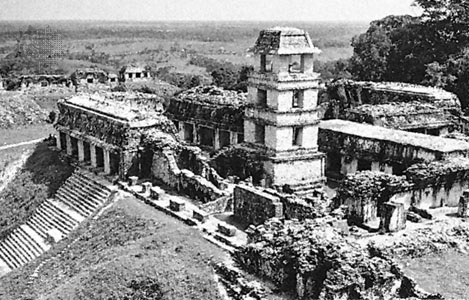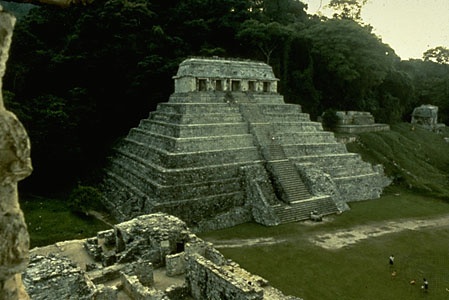Palenque
ancient city, Mexico
 ruined ancient Mayan (Maya) city of the Late Classic Period (c. AD 600–900) in what is now Chiapas state, Mexico, about 80 miles (130 km) south of Ciudad del Carmen. Its original name is speculative; the site now shares the name the Spanish gave to a neighbouring village. The city's ruins were designated a UNESCO World Heritage site in 1987.
ruined ancient Mayan (Maya) city of the Late Classic Period (c. AD 600–900) in what is now Chiapas state, Mexico, about 80 miles (130 km) south of Ciudad del Carmen. Its original name is speculative; the site now shares the name the Spanish gave to a neighbouring village. The city's ruins were designated a UNESCO World Heritage site in 1987.The Palenque builders used plaster to obtain a smooth finish, unlike the usual Mayan tooled-limestone construction. However, they used carving on the interior walls; the best examples are on tablets affixed to the walls with plaster. Stucco and terra-cotta images have been found. The elaborate palace complex includes three parallel walls housing two corridors covered with pointed vaults of the Palenque style.
 One of the largest and best-preserved structures, the Temple of the Inscriptions, is noted for its hieroglyphic inscriptions. In 1952 a crypt was discovered under the temple, in which were found the jade-ornamented remains of what may have been a ruler-priest of the 7th century AD. The Temple of the Sun is noted for a large stucco bas-relief of a beautifully modeled throne and figures.
One of the largest and best-preserved structures, the Temple of the Inscriptions, is noted for its hieroglyphic inscriptions. In 1952 a crypt was discovered under the temple, in which were found the jade-ornamented remains of what may have been a ruler-priest of the 7th century AD. The Temple of the Sun is noted for a large stucco bas-relief of a beautifully modeled throne and figures.people
also called Guarine,
Indian tribe of northern Venezuela at the time of the Spanish conquest (16th century). The Palenque were closely related to the neighbouring Cumanagoto (q.v.); their language probably belonged to the Arawakan family. They were a tropical-forest people known to eat human flesh, to be warlike, and to live in settlements surrounded by palisades (palenques). The Patángoro (q.v.) of Colombia were also sometimes called Palenque because of their fortified settlements.
- trap-door spider
- trapezius muscle
- Trapp Family
- Trappist
- trapshooting
- Traralgon
- Trasimeno, Lake
- Trask, Kate Nichols
- Traube, Isidor
- Traubel, Helen
- Traun
- Trauner, Alexandre
- Traun, Otto Ferdinand, Graf von Abensperg und
- trautonium
- Trauttmansdorff, Maximilian, Graf von
- Travancore
- Travelers Insurance
- traveler's tree
- traveling salesman problem
- Traven, B.
- Traverse City
- Travers, P.L.
- travertine
- travesty
- Travis Hirschi